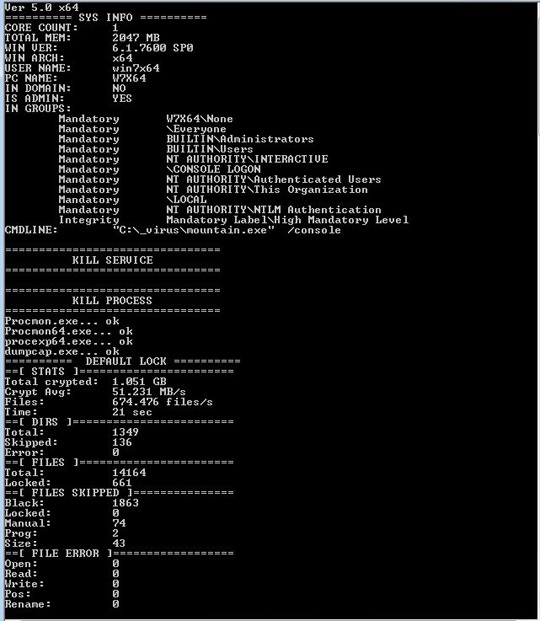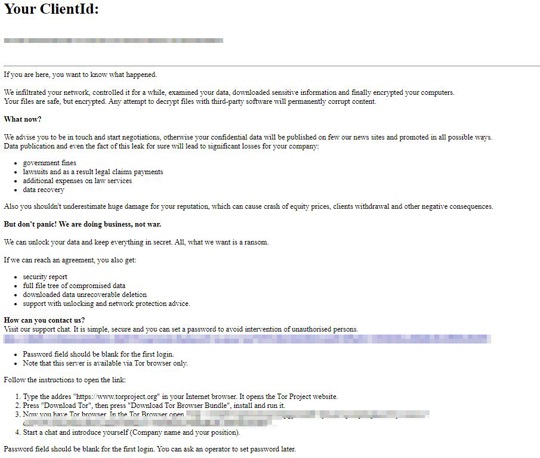Ransom.Win64.MOUNTLOCKER.E
Trojan-Ransom.Win32.Gen.abaf (KASPERSKY); a variant of Win64/Filecoder.MountLocker.B trojan (NOD32)
Windows


Threat Type: Ransomware
Destructiveness: No
Encrypted: No
In the wild: Yes
OVERVIEW
This Ransomware arrives on a system as a file dropped by other malware or as a file downloaded unknowingly by users when visiting malicious sites.
It drops files as ransom note. It avoids encrypting files with the following file extensions.
TECHNICAL DETAILS
Arrival Details
This Ransomware arrives on a system as a file dropped by other malware or as a file downloaded unknowingly by users when visiting malicious sites.
Installation
This Ransomware drops the following files:
- %User Temp%\{random characters}.bat -> contains commands to delete original malware executable
- {Malware File Path}\{Malware File Name}.log -> log file
(Note: %User Temp% is the current user's Temp folder, which is usually C:\Documents and Settings\{user name}\Local Settings\Temp on Windows 2000(32-bit), XP, and Server 2003(32-bit), or C:\Users\{user name}\AppData\Local\Temp on Windows Vista, 7, 8, 8.1, 2008(64-bit), 2012(64-bit) and 10(64-bit).)
It adds the following processes:
- cmd /c ""%User Temp%\{Random characters}.bat" {Malware file path and name}" -> to delete itself after execution
(Note: %User Temp% is the current user's Temp folder, which is usually C:\Documents and Settings\{user name}\Local Settings\Temp on Windows 2000(32-bit), XP, and Server 2003(32-bit), or C:\Users\{user name}\AppData\Local\Temp on Windows Vista, 7, 8, 8.1, 2008(64-bit), 2012(64-bit) and 10(64-bit).)
Other System Modifications
This Ransomware adds the following registry entries as part of its installation routine:
HKEY_CURRENT_USER\Software\Classes\
{Generated ID}\shell\Open\
command
(Default) = explorer.exe RecoveryManual.html -> causes the opening of ransom note when an encrypted file is opened
Process Termination
This Ransomware terminates the following services if found on the affected system:
- Services with the following strings in its service name:
- SQL
- database
- msexchange
It terminates the following processes if found running in the affected system's memory:
- agntsvc.exe
- dbeng50.exe
- dbsnmp.exe
- dumpcap.exe
- encsvc.exe
- excel.exe
- firefoxconfig.exe
- infopath.exe
- ipython.exe
- isqlplussvc.exe
- msaccess.exe
- msftesql.exe
- mspub.exe
- mydesktopqos.exe
- mydesktopservice.exe
- mysqld.exe
- mysqld-nt.exe
- mysqld-opt.exe
- ocautoupds.exe
- ocomm.exe
- ocssd.exe
- onenote.exe
- oracle.exe
- outlook.exe
- powerpnt.exe
- procexp.exe
- procexp64.exe
- procmon.exe
- procmon64.exe
- python.exe
- QBW32.exe
- QBW64.exe
- sqbcoreservice.exe
- sqlagent.exe
- sqlbrowser.exe
- sqlservr.exe
- sqlservr.exe
- sqlwriter.exe
- steam.exe
- synctime.exe
- tbirdconfig.exe
- thebat.exe
- thebat64.exe
- thunderbird.exe
- visio.exe
- winword.exe
- wordpad.exe
- wpython.exe
- xfssvccon.exe
Information Theft
This Ransomware gathers the following data:
- Core Count
- Total Memory
- Windows Version
- Windows Architecture
- User Name
- Computer Name
- Join status information
Other Details
This Ransomware does the following:
- It accepts the following parameters:
- /LOGIN - stolen login credentials
- /PASSWORD -stolen login credentials
- /CONSOLE - display console

- /NODEL - skip self deletion
- /NOKILL - will not terminate services and processes
- /NOLOG - no log file
- /SHAREALL - encrypt network shares
- /NETWORK{w|s} - execute malware in network shares
- /PARAMS
- /TARGET - indicate target path
- /FAST - fast encryption mode
- /MIN
- /MAX
- /FULLPD
- /MARKER - create file serving as the infection marker
- /NOLOCK - indicate file to avoid
- It checks if SQL is installed in the following folders:
- Program Files
- Program Files (x86)
- ProgramData
- It propagates in the network via LDAP domain query in Active Directories and drops copies of itself as:
- \C$\ProgramData\{Malware File Name}.exe
- Once propagation is successful, it will install the following service for malware execution:
- Update{random}
Ransomware Routine
This Ransomware avoids encrypting files with the following strings in their file name:
- bootmgr
- RecoveryManual.html
It avoids encrypting files found in the following folders:
- :\Windows\
- :\SystemVolumeInformation\
- :\$RECYCLE.BIN\
- :\SYSTEM.SAV
- :\WINNT
- :\$WINDOWS.~BT\
- :\Windows.old\
- :\PerfLog\
- :\Boot
- :\ProgramData\Microsoft\
- :\ProgramData\Packages\
- $\Windows\
- $\SystemVolumeInformation\
- $\$RECYCLE.BIN\
- $\SYSTEM.SAV
- $\WINNT
- $\$WINDOWS.~BT\
- $\Windows.old\
- $\PerfLog\
- $\Boot
- $\ProgramData\Microsoft\
- $\ProgramData\Packages\
- \WindowsApps\
- \Microsoft\Windows\
- \Local\Packages\
- \WindowsDefender
- \microsoftshared\
- \Google\Chrome\
- \MozillaFirefox\
- \Mozilla\Firefox\
- \InternetExplorer\
- \MicrosoftEdge\
- \TorBrowser\
- \AppData\Local\Temp\
It appends the following extension to the file name of the encrypted files:
- .ReadManual.{Generated ID}
It drops the following file(s) as ransom note:
- {Encrypted Directory}\RecoveryManual.html

It avoids encrypting files with the following file extensions:
- bat
- cat
- cmd
- dll
- exe
- fon
- inf
- lnk
- msi
- mui
- ps1
- sys
- ttf
- vbs
- ReadManual.{Generated ID}
SOLUTION
Step 1
Trend Micro Predictive Machine Learning detects and blocks malware at the first sign of its existence, before it executes on your system. When enabled, your Trend Micro product detects this malware under the following machine learning name:
-
Troj.Win32.TRX.XXPE50FFF044
Step 2
Before doing any scans, Windows 7, Windows 8, Windows 8.1, and Windows 10 users must disable System Restore to allow full scanning of their computers.
Step 3
Note that not all files, folders, and registry keys and entries are installed on your computer during this malware's/spyware's/grayware's execution. This may be due to incomplete installation or other operating system conditions. If you do not find the same files/folders/registry information, please proceed to the next step.
Step 4
Restart in Safe Mode
Step 5
Delete this registry value
Important: Editing the Windows Registry incorrectly can lead to irreversible system malfunction. Please do this step only if you know how or you can ask assistance from your system administrator. Else, check this Microsoft article first before modifying your computer's registry.
- HKEY_CURRENT_USER\Software\Classes\{Generated ID}\shell\Open\command
- (Default) = explorer.exe RecoveryManual.html
Step 6
Search and delete these files
- %User Temp%\{random characters}.bat
- {Malware File Path}\{Malware File Name}.log
Step 7
Restart in normal mode and scan your computer with your Trend Micro product for files detected as Ransom.Win64.MOUNTLOCKER.E. If the detected files have already been cleaned, deleted, or quarantined by your Trend Micro product, no further step is required. You may opt to simply delete the quarantined files. Please check this Knowledge Base page for more information.
Step 8
Restore encrypted files from backup.
Did this description help? Tell us how we did.

